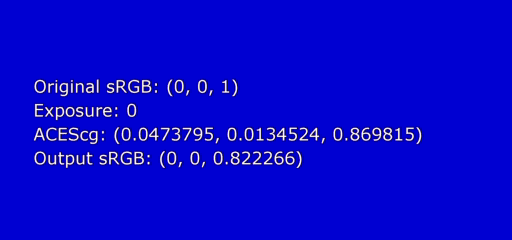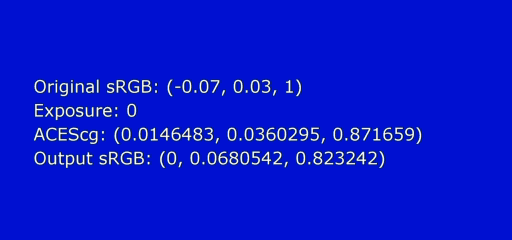Hey guys,
I have thought of a couple more things overnight. ![]()
I always go back to this simple example. What’s happening here ? By increasing the exposure on a sRGB blue primary, the blue channel is arriving first at 1 (or 100% emission) and cannot go beyond. Indeed displays have limitations and do not magically go to white. Then the red channel and green channels catch up creating a hue shift towards purple.

Shall we agree on the following :
- It is desirable to respect the creative intent when going from scene to display.
- Per-channel distorts the RGB ratios of the scene and therefore does not respect the creative intent.
- If such a hue shift was desirable, it should be a creative decision and not a default behavior.
I think it would be a step forward if we agreed on these three statements.
I have said earlier in this post that adding 7-8% of green would be a compensation for this behavior. I think it is worth nothing that by doing so, we are just changing the skew direction and not necessarily fixing the issue.

The epiphany I have had so far with this VWG is that the path to white must be engineered on a digital display (it was also engineered for film, agreed, but I would not remotely compare per-channel with film emulsion). We always come back to this fundamental question :
What should happen to values that are even more intense than 100% emission ? Just leave them stuck at the maximal value ?
And since we are as well having this great debate about film vs eye, I thought of another silly experiment :
- Put on a blue shirt, go outside to get hit by sunlight. Does the blue shirt get purple ? Do you expect it to get purple ?
- Go back home, put on a red shirt, go outside to get hit by sunlight. Does the red shirt get orange ? Do you expect it to get orange ?
Finally, per-channel is indeed engineered (nice catch @ruslan.sorokin ) but shall we agree that it is the responsibility of this VWG to at least investigate and discuss more elaborate transforms ? Since respecting the creative intent is our goal here ?
A side note : I would not literally spend hours writing these posts and providing these examples if I didn’t care about ACES. I think this VWG has some of the best people in the industry which is why I have high hopes/expectations for the outcome.
Update : I forgot to share with you a beautiful answer from one the lookdev supervisors I contacted.
[…] the calibration of an asset should be completely independent of the quality of the Output transform, of the tone mapping and in the broad sense of the look (CDL, LUT, etc …) applied to the images.
Chris